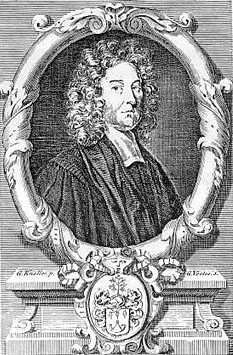| Thomas Burnet  Born: 1635 Born: 1635
Birthplace: Croft, Yorkshire, England
Died: 27-Sep-1715
Location of death: Godalming, Surrey, England
Cause of death: unspecified
Gender: Male
Race or Ethnicity: White
Occupation: Religion Nationality: England
Executive summary: Telluris Tehoria Sacra English divine, born at Croft in Yorkshire about the year 1635. He was educated at Northallerton, and at Clare Hall, Cambridge. In 1657 he was made fellow of Christ's, and in 1667 senior proctor of the university. By the interest of James, duke of Ormonde, he was chosen master of the Charterhouse in 1685, and took the degree of D.D. As master he made a noble stand against the illegal attempts to admit Andrew Popham as a pensioner of the house, strenuously opposing an order of the 26th of December 1686, addressed by James II to the governors dispensing with the statutes for the occasion.
Burnet published his famous Telluris Theoria Sacra, or Sacred Theory of the Earth, at London in 1681. This work, containing a fanciful theory of the earth's structure, attracted much attention, and he was afterwards encouraged to issue an English translation, which was printed in folio, 1684-89. Joseph Addison commended the author in a Latin ode, but his theory was attacked by John Keill, William Whiston and Erasmus Warren, to all of whom he returned answers. His reputation obtained for him an introduction at court by Archbishop Tillotson, whom he succeeded as clerk of the closet to King William. But he suddenly marred his prospects by the publication, in 1692, of a work entitled Archacologiae Philosophicae: sive Doctrina antique de Rerum Originibus, in which he treated the Mosaic account of the fall of man as an allegory. This excited a great clamor against him; and the king was obliged to remove him from his office at court. Of this book an English translation was published in 1729. Burnet published several other minor works before his death, which took place at the Charterhouse on the 27th September 1715. Two posthumous works appeared several years after his death -- De Fide et Officiis Christianorum (1723), and De Statu Mortuorum et Resurgentium Tractatus (1723); in which he maintained the doctrine of a middle state, the millennium, and the limited duration of future punishment. A Life of Dr. Burnet, by Heathcote, appeared in 1759.
University: Clare Hall, Cambridge University
Do you know something we don't?
Submit a correction or make a comment about this profile
Copyright ©2019 Soylent Communications
|